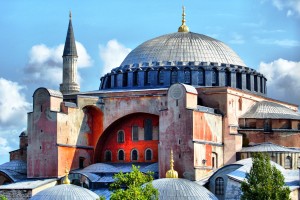The Great Calligraphic Planes were originally located on the original Hagia Sophia Church/Mosque. They were huge rounded panes (approximately 7.5 meters in width) that hung on the walls of the mosque. These calligraphic panes are written on a 7.5 meter rounded object with gilt on a green background that was made of hemp. As far as the actual hanging of the calligraphic panes, they are hung with limelight because it is a lightweight and durable material. Kazasker Mustafa Izzet Efendi was the initial calligraphic writer for these panes and was also famous for his calligraphy during the repairs of the Hagia Sophia after it was taken over in the years of 1847-1849. During this time, Kazasker Mustafa Izzet Efendi made eight of these large panes. The panes contained the names: Allah, Muhammad, the four caliphs (Abu Bakr, Umar, Uthman, and Ali) and also the grandsons of Muhammad: Hasan and Hussein. These eight panes are the largest calligraphic panes in the Islamic world to date. The picture below is what the panes currently look like.
(http://www.photographium.com/apse-mosaic-between-calligraphic-panes-in-hagia-sophia-ayasofya-camii-containing-the-names-of-allah-and-prophet-muhammad-istanbul-turkey-2014-june-23)
(http://phototrekistanbul.blogspot.com/2014/12/ayasofya-muzesi-hagia-sophia-divine.html)
These calligraphic panes are unique to the Hagia Sophia and because of that they still exist in the museum today. I think that they are a vital part of the culture of Istanbul which is why they still hang today. Although they are not unique to the original Christian church, they are a significant part of the reformation of the Hagia Sophia.
